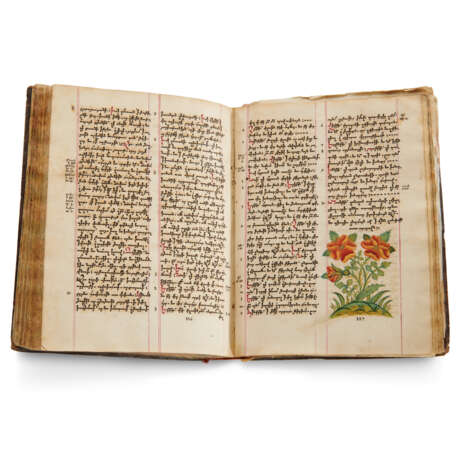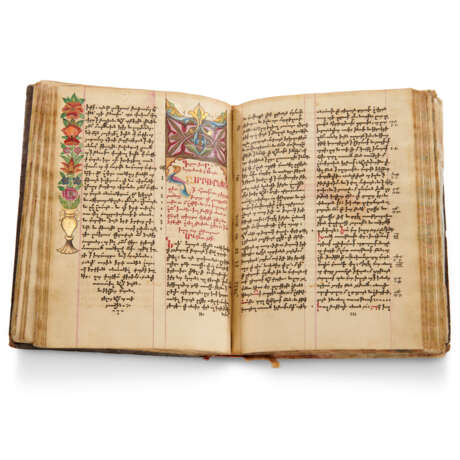ID 794455
Lot 47 | Anonymous Armenian artist
Estimate value
£ 10 000 – 15 000
Four Commentaries on King Solomon’s Song of Songs, in classical Armenian (grabar), illuminated manuscript on paper Ejmiatsin, Armenia, 1787.
A striking compilation of commentaries on the Song of Songs, written in classical Armenian by the scribe, clerk, and notary Yohan Vagharshapatets’i for the patron Yakob (Hagop) vardapet.
218 x 168 mm., 146 leaves, paginated 2-232 in ink by the scribe below the right-hand column (pp.233-235 paginated in a later hand), collation: p8 ?7 (of 8, lacking viii of which only a stub remains) [1]3 (of 4, lacking iv) 2-158 [16]8 [17]8 ; (missing 1 leaf, pp.7-8 in gathering [1]), 3 detached leaves of a different paper stock at the end, one of which is a red, yellow, green decorated paste paper, catchwords on every verso, 2 columns of 30-31 lines each, the text mostly notrgir (notary) script with some bolorgir (minuscule) and erkat’agir (majuscule) throughout, pp.231-235 in shghagir script (modern ligatured script) by a non-professional scribe dated 30 May 1829, ruled space: c.170 x 56 mm, includes a decorated title page (p. [1]) in one column of 19 lines, decorative bird and animal-shaped initials, three 1-column headpieces indicating the beginning of the first three commentaries, decorative flowers at the end of the first, second, and fourth commentaries and in margins. Modified traditional Armenian binding structure decorated in a western European manner with a blind tooled double border of floral designs and gold tooled using three different stamps repeated 12 times in corners, top, bottom, and sides, and a group in the center. The upper and lower boards are tooled in the same manner. Red silk cloth lines the inner boards. Head, tail, and fore-edge painted with floral decorations.
Provenance:
(1) Original patron/owner 1787: Yakob (Hagop) vardapet.
(2) Probably in the possession of Georg [P’]ilipposean Erewants’i Ghazareants’ in 1829.
(3) Prince Georgy Vasilyevich Obolensky (1826-1886): inscription '?. ?. ??. ???????????'. Obolensky was a lawyer and lieutenant general of the Imperial Russian Army. A second inscription is almost illegible and reads: '???????? / ?????? (?), or 'Romanov / Lopachi (?)'.
Content: Title page p.1; prologue pp.2-6; Commentary on the Song of Songs by St. Gregory of Narek pp.9-76; Commentary on the Song of Songs by Origen pp.77-110; Commentary on the Song of Songs by Vardan Arewelts’i pp.110- 171; Commentary on the Song of Songs by Gregory of Tat’ew pp.171-227; colophon pp.229-230; later text (not related to the Song of Songs) dated 30 May 1829 pp.231-235.
This manuscript is a compilation of four Commentaries on the Old Testament Song of Songs, copied in a professional notrgir script by the highly skilled scribe and clerk Yohan Vagharshapatets’i in 1787. There are many Armenian manuscripts with multiple commentaries on this biblical text in various combinations. The first commentary in this compilation is by the famous St. Gregory of Narek (or Grigor Narekats’i, ca. 945-1003), beloved by Armenians for his Book of Lamentations, mystical prayers, poetry, hymns, homilies, and other works. His commentary on the Song of Songs, his earliest work, was written at the request of Prince Gurgen Artsruni in 977.
The second text is the Armenian translation of the Commentary written by Origen (3rd century Greek theologian and ascetic from Alexandria).
The third was penned in the 13th century by Vardan (Arewelts’i) “the Great” (ca. 1200-1271), scholar, educator, and vardapet (learned priest) best known for his History and Geography.
The fourth and last commentary was composed by Gregory of Tat’ew (Grigor Tat’ewats’i (ca. 1344-1409), renowned exegete, scholar, and teacher.
A later text added after the commentaries on pp.231-235, as well as a short inscription on the first (unnumbered) page of the manuscript, were written in a non-professional shghagir script by Georg [P’]ilipposean Erewants’i Ghazareants’ in holy Ejmiatsin and dated 30 May 1829. This text is not connected with the Song of Songs. It consists of an excerpt from the History of Ghewond vardapet (late 8th c.) regarding the story of the all-saving portrait of the image of God Jesus Christ, and another text mentioning Grigor Magistros and regarding the same image of Christ now held in Ejmiatsin. We thank Prof. Sergio La Porta for deciphering this section and identifying the text.
This manuscript was produced in the late 18th century (1787), quite late by European standards but not so uncommon in the Near East in East Christian, Jewish, and Islamic traditions due to the late introduction of the printing press to these regions. It includes a title page, which is unusual in manuscripts but common in printed books, clearly showing the scribe and artist’s knowledge of and exposure to books produced on a printing press. The floral decorations are unrelated to the text and are included simply to embellish and beautify the book. In the 17th to 18th centuries, such motifs become more prevalent in both late Armenian and Islamic manuscripts, and were possibly introduced through exposure to western European printed herbal books.
Illumination:
Title page (p. [1]) formed of an ogee-shaped arch filled with a variety of colourful flowers and leaves, along with vine scrolls in the left, bottom, and right borders;
p.9 Beginning of Gregory of Narek’s commentary marked by a headpiece in left column with Lamb of God holding red banner, decorative initial ? (Armenian H) formed by brown long-necked animal, with a floral design in gold below it, marginal decoration of red poppies in right margin;
p.76 Bottom half of right column filled with large purple flowers (carnations?);
p.77 Beginning of Origen’s commentary, indicated by a headpiece in the left column of curved arabesque designs, decorative initial ? (Armenian H) formed of an orange-brown fox, marginal decoration on right which matches the headpiece;
p.110 Beginning of Vardan Arewelts’i’s commentary, with right column headpiece of curved arabesque design, decorative initial ? (Armenian H) formed by a bird, in left margin a gold vase from which sprouts a profusion of colorful flowers;
p.171 Beginning of Gregory of Tat’ew’s commentary in middle of left column, marked by a traditional decorative initial ? (Armenian V) formed of a large bird feeding its young in dark red ink.
p.227 Three large red roses at bottom of second column.
Christie's would like to thank Dr Sylvie Merian for her expertise in cataloguing this lot.
Literature
The Blessing of Blessings: Gregory of Narek’s Commentary on the Song of Songs, translation, introduction, and notes by Roberta R. Ervine (Kalamazoo, MI: Cistercian Publications, 2007).
Arsen Harut’yunyan, “XVIII dari erku norahayt dze?agir ev mi dze?ats’ khach’,” Banber Matenadarani 24 (2017): 209-221.
Robert W. Thomson, “Gregory of Narek’s ‘Commentary on the Song of Songs’,” The Journal of Theological Studies, new series, 34: 2 (October 1983): 453-496.
Special notice
No VAT on hammer price or buyer's premium.
| Place of origin: | Armenia, Asia |
|---|---|
| Auction house category: | Medieval & renaissance manuscripts |
| Place of origin: | Armenia, Asia |
|---|---|
| Auction house category: | Medieval & renaissance manuscripts |
| Address of auction |
CHRISTIE'S 8 King Street, St. James's SW1Y 6QT London United Kingdom | |
|---|---|---|
| Preview |
| |
| Phone | +44 (0)20 7839 9060 | |
| Buyer Premium | see on Website | |
| Conditions of purchase | Conditions of purchase |








